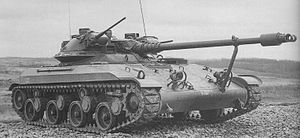| 76-mm Gun Tank, T92 | |
|---|---|
 T92 during its original trials | |
| Type | Light tank |
| Place of origin | United States |
| Production history | |
| Designer | Aircraft Armaments, Incorporated (AAI) |
| Designed | 1954–1958 |
| Manufacturer | AAI |
| Produced | 1956–1958 |
| No. built | 2 prototypes |
| Specifications | |
| Mass | 18 tons |
| Length | 6.273 m (20 ft, 7 in) (4.8 m (15 ft, 9 in) without gun) |
| Width | 3.149 m (10 ft, 4 in) (over the tracks) |
| Height | 2.26 m (7 ft, 5 in) (over the periscopes) |
| Crew | 4 (commander, gunner, loader and driver) |
| Armor | 10 to 32 mm of steel |
Main armament | 1× T185E1 76 mm rifled tank gun (60 rounds) |
Secondary armament | 1× M2HB 12.7 mm heavy machine gun in right cupola (700 rounds) 2× M37 7.62 mm machine gun, one in the right cupola and one coaxial (5000 rounds) |
| Engine | Continental AOI-628-1 8-cylinder opposed-piston gasoline engine 340 hp (250 kW) at 3200 RPM |
| Power/weight | 18.3 hp (13.6 kW)/t |
| Transmission | Allison XT-300, automatic (6 Fwd/2 Rwd) [1] |
| Suspension | Torsilastic |
| Ground clearance | 43.1 cm (1 ft, 5 in) |
| Fuel capacity | 682 liters (180 gal) |
Operational range | 338 km (210 mi) |
| Maximum speed | 56 km/h (35 mph) |
The T92 Light Tank, or 76-mm Gun Tank, T92, was an American light tank developed in the 1950s by Aircraft Armaments. It was designed as an airborne/airdropped replacement for the heavier M41 Walker Bulldog while retaining the mobility, protection level, and firepower of the latter. The unveiling of the Soviet PT-76 amphibious light tank pointed out that the future US light tank should be able to swim as well. Making the T92 amphibious was deemed impractical and the light gun tank program was cancelled in June 1958. [1]